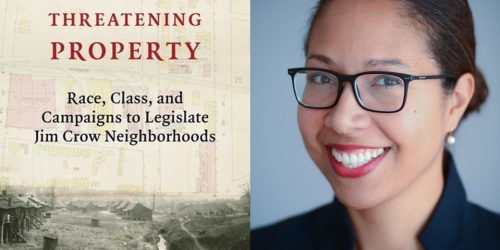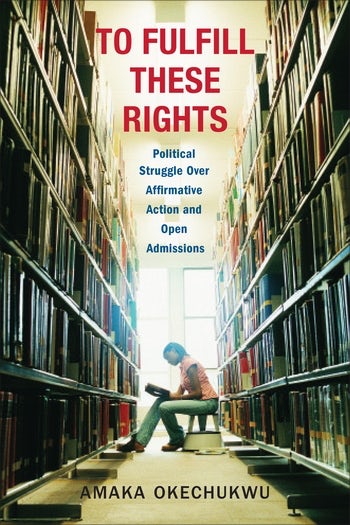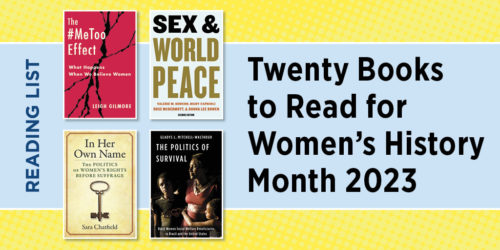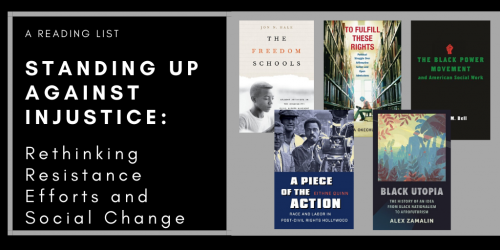We Stand in Solidarity with All Those Peacefully Protesting Injustice

Columbia University Press strongly condemns the unjust killing of George Floyd and the deaths of many who went before him. We protest the systemic racism that plagues our country, and we must dedicate ourselves to eradicating it. We stand in solidarity with all those peacefully protesting injustice, including Columbia colleagues and students.
At the Press, one way forward is through the books we publish and the books we read. In this time of bearing witness to such a stark example of injustice and inequality, we reflect on our mission to publish outstanding works that contribute to global human concerns. As Columbia University President Lee Bollinger wrote earlier this week, “More than anything we will continue to provide the society and the world with all the knowledge we can preserve and create and with a new generation of citizens and leaders who are prepared to live by, and fight for, the values of respect for reason, the love of ideas, and the wish to use these to care for others.”
We offer a reading list of recently published Columbia books that speak to this moment.
Why Civil Resistance Works
The Strategic Logic of Nonviolent Conflict
Erica Chenoweth and Maria J. Stephan
For more than a century, from 1900 to 2006, campaigns of nonviolent resistance were more than twice as effective as their violent counterparts in achieving their stated goals. By attracting impressive support from citizens, whose activism takes the form of protests, boycotts, civil disobedience, and other forms of nonviolent noncooperation, these efforts help separate regimes from their main sources of power and produce remarkable results, even in Iran, Burma, the Philippines, and the Palestinian Territories.
Mahatma Gandhi
Nonviolent Power in Action
Dennis Dalton
Dennis Dalton’s classic account of Gandhi’s political and intellectual development focuses on the leader’s two signal triumphs: the civil disobedience movement (or salt satyagraha) of 1930 and the Calcutta fast of 1947. Dalton clearly demonstrates how Gandhi’s lifelong career in national politics gave him the opportunity to develop and refine his ideals. He then concludes with a comparison of Gandhi’s methods and the strategies of Martin Luther King Jr. and Malcolm X, drawing a fascinating juxtaposition that enriches the biography of all three figures and asserts Gandhi’s relevance to the study of race and political leadership in America.
Threatening Property
Race, Class, and Campaigns to Legislate Jim Crow Neighborhoods
Elizabeth A. Herbin-Triant
In Threatening Property, Elizabeth A. Herbin-Triant investigates early-twentieth-century campaigns for residential segregation laws in North Carolina to show how the version of white supremacy supported by middle-class white people differed from that supported by the elites. Class divides prevented Jim Crow from expanding to the extent that it would require separate neighborhoods for black and white southerners as in apartheid South Africa.
Race and Real Estate
Conflict and Cooperation in Harlem, 1890-1920
Kevin McGruder
This book also introduces alternative reasons behind African Americans’ migration to Harlem, showing that they came not to escape poverty but to establish a lasting community. Owning real estate was an essential part of this plan, along with building churches, erecting youth-serving facilities, and gaining power in public office. In providing a fuller, more nuanced history of Harlem, McGruder adds greater depth in understanding its development and identity as both an African American and a biracial community.
How the Suburbs Were Segregated
Developers and the Business of Exclusionary Housing, 1890–1960
Paige Glotzer
Paige Glotzer offers a new understanding of the deeper roots of suburban segregation. The mid-twentieth-century policies that favored exclusionary housing were not simply the inevitable result of popular and elite prejudice, she reveals, but the culmination of a long-term effort by developers to use racism to structure suburban real estate markets.
The Dream Revisited
Contemporary Debates About Housing, Segregation, and Opportunity
Edited by Ingrid Gould Ellen and Justin Peter Steil
The Dream Revisited brings together a range of expert viewpoints on the causes and consequences of the nation’s separate and unequal living patterns. Leading scholars and practitioners, including civil rights advocates, affordable housing developers, elected officials, and fair housing lawyers, discuss the nature of and policy responses to residential segregation. Essays scrutinize the factors that sustain segregation, including persistent barriers to mobility and complex neighborhood preferences, and its consequences from health to home finance and from policing to politics.
To Fulfill These Rights
Political Struggle Over Affirmative Action and Open Admissions
Amaka Okechukwu
In To Fulfill These Rights, Amaka Okechukwu offers a historically informed sociological account of the struggles over affirmative action and open admissions in higher education. Through case studies of policy retrenchment at public universities, she documents the protracted—but not always successful—rollback of inclusive policies in the context of shifting race and class politics.
The Black Power Movement and American Social Work
Joyce M. Bell
Relying on extensive archival research and oral history interviews, Joyce M. Bell follows two groups of black social workers in the 1960s and 1970s as they mobilized Black Power ideas, strategies, and tactics to change their national professional associations. Comparing black dissenters within the National Federation of Settlements (NFS), who fought for concessions from within their organization, and those within the National Conference on Social Welfare (NCSW), who ultimately adopted a separatist strategy, she shows how the Black Power influence was central to the creation and rise of black professional associations.
Race Capital?
Harlem as Setting and Symbol
Edited by Andrew M. Fearnley and Daniel Matlin
As debate swirls around Harlem’s present and future, Race Capital? revisits a century of the area’s history, culture, and imagery, exploring how and why it achieved its distinctiveness and significance and offering new accounts of Harlem’s evolving symbolic power.
Topics explored include Harlem as a literary phenomenon; recent critiques of Harlem exceptionalism; gambling and black business history; the neighborhood’s transnational character; its importance in the black freedom struggle; black queer spaces; and public policy and neighborhood change in historical context.
Black Utopia
The History of an Idea from Black Nationalism to Afrofuturism
Alex Zamalin
In Black Utopia, Alex Zamalin offers a groundbreaking examination of African American visions of social transformation and their counterutopian counterparts. Considering figures associated with racial separatism, postracialism, anticolonialism, Pan-Africanism, and Afrofuturism, he argues that the black utopian tradition continues to challenge American political thought and culture.
A Haven and a Hell
The Ghetto in Black America
Lance Freeman
In A Haven and a Hell, Lance Freeman examines how the ghetto shaped black America and black America shaped the ghetto. Freeman traces the evolving role of predominantly black neighborhoods in northern cities from the late nineteenth century through the present day. At times, the ghetto promised the freedom to build black social institutions and political power. At others, it suppressed and further stigmatized African Americans.
Banking on Freedom
Black Women in U.S. Finance Before the New Deal
Shennette Garrett-Scott
Banking on Freedom offers an unparalleled account of how black women carved out economic, social, and political power in contexts shaped by sexism, white supremacy, and capitalist exploitation. Garrett-Scott chronicles both the bank’s success and the challenges this success wrought, including extralegal violence and aggressive oversight from state actors who saw black economic autonomy as a threat to both democratic capitalism and the social order.
The Freedom Schools
Student Activists in the Mississippi Civil Rights Movement
Jon N. Hale
Based on dozens of first-time interviews with former Freedom School students and teachers and on rich archival materials, this remarkable social history of the Mississippi Freedom Schools is told from the perspective of those frequently left out of civil rights narratives that focus on national leadership or college protestors. Hale reveals the role that school-age students played in the civil rights movement and the crucial contribution made by grassroots activists on the local level.
Desegregating the Past
The Public Life of Memory in the United States and South Africa
Robyn Autry
The scale at which violent racial pasts have been incorporated into South African national historical narratives is lacking in the U.S. Desegregating the Past considers why this is the case, tracking the production and display of historical representations of racial pasts at museums in both countries and what it reveals about underlying social anxieties, unsettled emotions, and aspirations surrounding contemporary social fault lines around race.
Afro-Dog
Blackness and the Animal Question
Bénédicte Boisseron
In Afro-Dog, Bénédicte Boisseron investigates the relationship between race and the animal in the history and culture of the Americas and the black Atlantic, exposing a hegemonic system that compulsively links and opposes blackness and animality to measure the value of life. She analyzes the association between black civil disobedience and canine repression, a history that spans the era of slavery through the use of police dogs against protesters during the civil rights movement of the 1960s to today in places like Ferguson, Missouri.
Shadow Archives
The Lifecycles of African American Literature
Jean-Christophe Cloutier
Recasting the history of African American literature, Shadow Archives brings to life a slew of newly discovered texts—including Claude McKay’s Amiable with Big Teeth—to tell the stories of black special collections and their struggle for institutional recognition. Jean-Christophe Cloutier offers revelatory readings of major African American writers, including McKay, Richard Wright, Ann Petry, and Ralph Ellison, and provides a nuanced view of how archival methodology, access, and the power dynamics of acquisitions shape literary history.
Race and Ethnicity in America
A Concise History
Edited by Ronald H. Bayor
Spanning from 1600 to 2000 and covering everything from the Trail of Tears to the Black Power movement, Race and Ethnicity in America is comprehensive both chronologically and in terms of ethnic groups addressed: It examines not only the history of black-white relations in America, but also the experiences of Irish Catholics, Native Americans, Latinos, Jews, and many others. Topics covered include anti-Catholicism and nativism, slavery and abolitionism, Indian removal, assimilation and scientific racism, the National Origins Act, the civil rights movement, and contemporary debates over affirmative action and bilingualism.
America the Beautiful and Violent
Black Youth and Neighborhood Trauma in Chicago
Dexter R. Voisin
America the Beautiful and Violent is built around the powerful voices and insights of black youth in Chicago and their parents and communities. Voisin interweaves their narratives with data, research findings, and historical accounts that provide context for their experiences. He highlights the broad historical, political, economic, and racial factors that shape the construction, concentration, and narratives of violence in black neighborhoods.
A Time to Stir: Columbia ’68
Edited by Paul Cronin
With more than sixty essays from members of the Columbia chapter of Students for a Democratic Society, the Students’ Afro-American Society, faculty, undergraduates who opposed the protests, “outside agitators,” and members of the New York Police Department, A Time to Stir sheds light on the politics, passions, and ideals of the 1960s. Moving beyond accounts from the student movement’s white leadership, this book presents the perspectives of black students, who were grappling with their uneasy integration into a supposedly liberal campus, as well as the views of women, who began to question their second-class status within the protest movement and society at large.
Categories:American HistoryColumbia UniversityCurrent EventsHistoryHuman RightsPoliticsReading ListUrban Studies
Tags:A Haven and a HellA Time to Stir: Columbia ’68Afro-DogAlex ZamalinAmaka OkechukwuAmerica the Beautiful and ViolentAndrew M. FearnleyBanking on FreedomBénédicte BoisseronBlack UtopiaDaniel MatlinDennis DaltonDesegregating the PastDexter R. VoisinElizabeth A. Herbin-TriantErica ChenowethHow the Suburbs Were SegregatedIngrid Gould EllenJean-Christophe CloutierJon N. HaleJoyce M. BellJustin Peter SteilKevin McGruderLance FreemanMahatma GandhiMaria J. StephanPaige GlotzerPaul CroninRace and Ethnicity in AmericaRace and Real EstateRace Capital?Robyn AutryRonald H. BayorShadow ArchivesShennette Garrett-ScottThe Black Power Movement and American Social WorkThe Dream RevisitedThe Freedom SchoolsThreatening PropertyTo Fulfill These RightWhy Civil Resistance Works



























